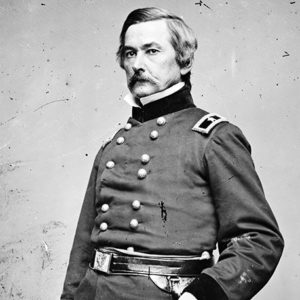calsfoundation@cals.org
Capture of Des Arc and DeValls Bluff
aka: Capture of DeValls Bluff and Des Arc
| Location: | Prairie County |
| Campaign: | White River Expedition (January 13–19, 1863) |
| Date: | January 18, 1863 |
| Principal Commanders: | Brigadier General Willis Gorman (US); None (CS) |
| Forces Engaged: | Steamers USS Romeo and USS Forest Rose, Twenty-fourth Indiana Infantry (US); None (CS) |
| Estimated Casualties: | 100 prisoners (CS) |
| Result: | Union victory |
Des Arc (Prairie County) and DeValls Bluff (Prairie County) became two important Union military outposts between Little Rock (Pulaski County) and Helena (Phillips County). The capture and protection of these towns was a high priority for Federal commanders from 1863 until the end of the war.
The towns were first captured by Federal troops in January 1863. An expedition was launched up the White River on January 13, 1863, after the capture of Arkansas Post (Arkansas County). Under the command of Brigadier General Willis Gorman, troops captured St. Charles (Arkansas County) on the first day of the expedition. Leaving the USS Cincinnati and several units behind, Gorman continued up the White River, and on January 18, the Federals captured DeValls Bluff. Linked to North Little Rock (Pulaski County) by a railroad, DeValls Bluff was important to the supply lines into Little Rock. The same day, the USS Romeo and the USS Forest Rose, along with the Twenty-fourth Indiana, captured Des Arc. While his troops ascended the White, Gorman’s command was continually stripped of units by Major General John McClernand, who required their use near Arkansas Post, and Gorman was unable to continue their expedition past Des Arc. They returned to St. Charles on January 20 and proclaimed the expedition a success with the capture of more than 100 prisoners, two cannon, food, and other war materiel. Both towns were surprised by the arrival of Federal forces and did not resist.
Federal forces continued to occupy Helena and the surrounding countryside, but DeValls Bluff and Des Arc returned to Confederate control. In August 1863, the Federal commander of Arkansas, Major General Frederick Steele, launched a campaign to capture Little Rock in light of the Union victory at the Battle of Helena on July 4. Federal cavalry under the command of Brigadier General John Wynn Davidson launched excursions throughout northeast Arkansas, ranging as far as Chalk Bluff (Clay County) and Jonesboro (Craighead County). On August 9, Davidson’s division reached Clarendon (Monroe County) and met several gunboats under the command of Lieutenant George Bache. The next day, Bache loaded some cavalry aboard and steamed to DeValls Bluff. The mission was launched to capture any trains or railroad cars in the town. The Federals did frighten away the few Confederate troops in the area but did not find a train.
Continuing to work together, Davidson and Bache traveled up the White to locate Confederate cavalry under the command of Brigadier General John Sappington Marmaduke. They arrived in Des Arc on August 12, taking some prisoners and burning a warehouse. The Federal warships continued up the White and Little Red rivers before turning back and returning to DeValls Bluff.
Steele led his troops out of Helena on August 10 and reached Clarendon on August 15. It took several days to transport the army across the White River, and each day more men fell ill due to the heat, lack of water, and general unhealthiness of the area. Steele turned his army northward to DeValls Bluff, which was considered a better location due to its elevation. By August 24, the bulk of the Federal force had arrived in the town, and it was quickly turned into both a hospital and supply depot for the campaign.
DeValls Bluff would continue to serve as an important Federal river port and railroad terminal during its occupation.
For additional information:
Christ, Mark K. Civil War Arkansas, 1863: The Battle for a State. Norman: University of Oklahoma Press, 2010.
The War of the Rebellion: A Compilation of the Official Records of the Union and Confederate Armies. Series 1, Vol. 22, Part 1. Washington DC: Government Printing Office, 1889.
David Sesser
Henderson State University
 Civil War Timeline
Civil War Timeline ACWSC Logo
ACWSC Logo  Willis A. Gorman
Willis A. Gorman 




Comments
No comments on this entry yet.